by Kimberly Lerch | Published: June 29, 2020

I love to do needlework; in particular, I love to do what is called “fancy work.”
What is Fancy Work?
Needlework encompasses all work done with the needle, whether it is necessary work or not. Darning, patching, repairing ripped seams, hemming, sewing buttons back on and the like were considered essential needlework for the housewife. It’s the needlework that is functional— the work that needs to be done. Fancy work is the needlework that doesn’t ‘need’ to be done. Both types of needlework require skill, but one is for function and the other, although it could serve a purpose, is done for its beauty and the sense of accomplishment it gives its creator.
Finding Fancy Work in Newspapers
I decided to search the Illinois Digital Newspaper Collections (IDNC) for the phrase “fancy work.” On a full-text search throughout the entire collection, I had 9,773 hits! Repeating and scaling down to search just through the Farm, Field, and Fireside (FFF) newspaper collection, I still had 1,703 hits.
I narrowed the search further by repeating it on all collections but limiting the search to the article titles containing “fancy work.” I had 67 hits. I think the difference came from the number of advertisements for patterns throughout these newspapers, not for actual articles on the topic.
I continued to refine my search; I searched through just the FFF collection and only article titles containing “fancy work.” I got back 59 results. It appears that the bulk of these “fancy work” articles were directed at the ‘farm crowd.’ 48 hits were from Farmer’s Wife alone; that makes sense—aimed right at their demographic, the farm housewife.
Types of Fancy Work
For this post, I have decided to cover French and eyelet/cutwork embroidery found in the fancy work articles in the Farmer’s Wife newspaper between 1906 and 1913. This kind of fancy work seemed to comprise the bulk of the articles.
Fancy work was referred to many times as ‘pickup work,’ particularly in the winter when there wasn’t much outdoor work that needed or could be done because of the weather and short days. It was the needlework that was turned to after all the necessary needlework was done. It was done for enjoyment.
Some articles would provide instruction to a technique, such as explaining how to execute a French knot, but most would simply have sketches of different kinds of projects with short descriptions and instructions as to how to order the pattern. The stitcher was expected to provide her own materials (base fabric, floss, thread, yarn, etc. as needed, although a few might, for a few cents more, offer to send along floss).
Patterns would usually be sent in one of two forms: perforated or iron on transfers. The perforated patterns would need to be ‘pounced;’ that is, a fine powder made of charcoal or charcoal/clay mix would be deposited on the material through the perforations onto the material, leaving behind the pattern on the fabric to be worked. Later, iron on transfers replaced the pouncing technique for copying the pattern to the fabric. You can still order iron on transfers for this type of embroidery online. Personally, I have used lots of Aunt Martha’s Embroidery Patterns!
Embroidery by far was the most popular work that was covered in the Fancy Work sections of the Farmer’s Wife. Two of the most popular types of embroidery at the time were:
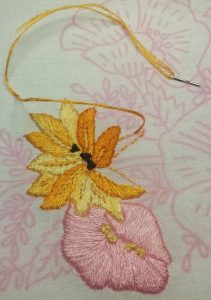
French
From looking at the patterns and the (sometimes available) names of the stitches suggested for use on the pattern, I’m going to assume (as I can’t find a good explanation of what French embroidery is, apart from any other kind of embroidery) it uses:
• stem
• outline
• running
• satin
• lazy daisy (that can be easily adapted to the chain stitch
— one lazy daisy coming out of the end of the previous lazy daisy)
• French knot.
Eyelet and Cutwork
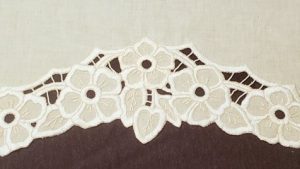
Eyelet work is created by poking holes (with a stiletto or small awl, depending on the size of the eyelet diameter desired) into the material, then satin or buttonhole stitching around the hole created. The holes are arranged in a pattern that, as a whole (hole?) is visually appealing without revealing too much. It was commonly done as white work (white thread or floss on a white ground material). Here the hole is created before the needle work is done. In cutwork, the stitches (again, satin or buttonhole as they are close together and keep the ground material from unraveling) are laid first, then the material is cut away carefully from the stitched-in area (hence, the name “cutwork”).
Where the Embroidery Could be Found in the Home
It’s an easier question to ask where the items weren’t found in the home! A variety of worked pieces could be found in almost every room of an early 20th-century American farmhouse.
In the Bedroom
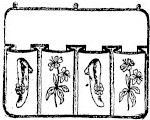
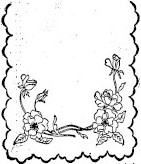
In the bedroom, embroidered pillow slips (cases) and bureau scarves were common. The designs on the items for the bedroom were usually floral, in colored floss and either edged in the buttonhole stitch or a row of evenly spaced crocheted stitches. The bureau scarf design to the right (Fig. 4) can be found in the Farmer’s Wife for December 1, 1906.
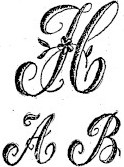
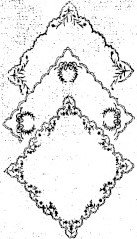
women’s handkerchiefs
A decorated slipper holder could have hung in the closet for the mistress’ indoor footwear. The slipper holder design on the left (Fig. 3) can be found in the Farmer’s Wife for August 1, 1910.
Handkerchiefs were embellished with florals, scrolls, eyelets, anything beautiful and dainty. The handkerchief designs to the right (Fig. 6) can be found in the Farmer’s Wife for January 1, 1907.
Monograms were popular on handkerchiefs as well as ‘luncheon clothes’ (napkins). The monogram design to the left (Fig. 5) can be found in the Farmer’s Wife for October 1, 1908.

It seems that folks back then had cases for everything! We have them for glasses and phones; they had them for collars, gloves, or ties. The case design to the left (Fig. 7) can be found in the Farmer’s Wife for January 1, 1910.

Crazy quilts were laid across beds, their embroidered seams seeking to impress rather than withstand stress. On the piece to the right (Fig. 8), I stitched feather, button-hole, French knot, straight, and lazy daisy stitches (along with a few seed beads snuck in!) in various combinations to bring to life what was in my imagination!
In the Parlor
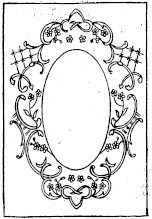
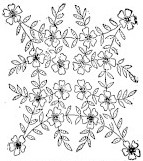
In the parlor, housewives proudly displayed their works of fiber art on their sofas. The pillow top design to the right (Fig. 10) can be found in the Farmer’s Wife for February 1, 1907. Embroidered frames were stitched to personalize photos of loved ones. The frame design to the left (Fig. 9) can be found in the Farmer’s Wife for February 1, 1910.
In my living room, my embroidered works are on the walls. There wasn’t one example of an embroidered piece being framed and hung on the wall in these newspapers!
In the Dining Room
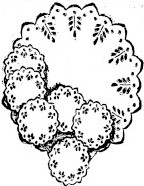
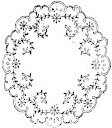
In the dining room, a hand-stitched centerpiece graced the dining room table and plate doilies took the place of chargers under the missus’ best china. ‘Luncheon cloths’ (linen napkins) were often monogrammed (see above for an example of a satin stitched monogram). The centerpiece design to the right (Fig. 12) can be found in the Farmer’s Wife for October 1, 1906. The centerpiece with the matching plate doilies design to the left (Fig. 11) can be found in the Farmer’s Wife for August 1, 1910.
In the Kitchen or Bathroom


In the kitchen or bathroom (if you were lucky enough to have one!), towels, beautifully embroidered along their borders, were hung on a wooden rack. The wooden rack itself sometimes had an embroidered piece glued to it (I told you nothing was safe from the stitcher’s decorating needle!). The embroidered towel rack design to the left (Fig. 13) can be found in the Farmer’s Wife for December 1, 1909. The embroidered towel border design to the right (Fig. 12) can be found in the Farmer’s Wife for August 1, 1908.
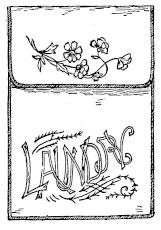
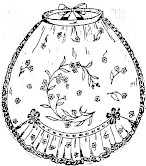
While in the kitchen, the cook was usually wearing an apron decorated with embroidery. Hanging in the corner, a fancied-up whisk broom holder may be found near the laundry bag. Both the apron on the right (Fig. 16) and the embroidered laundry bag on the left (Fig. 15) designs can be found in the Farmer’s Wife for September 1, 1910.
On the Family
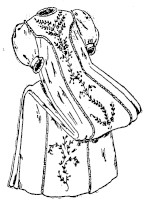
baby dress
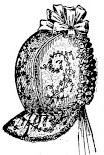
Once the stitcher was finished covering every surface in her house with floss-embellished fabric, she turned to her family. First was the baby. Everything but the diaper was decorated with embroidered flowers or all kinds of cute animals. The bonnet design to the right (Fig. 18) can be found in the Farmer’s Wife for January 1, 1909. Everyday clothes for babies and children were not adorned, but special clothes, seen by neighbors and relatives on special occasions, were. The dress design to the left (Fig. 17) can be found in the Farmer’s Wife for September, 1910. Even baby shoes and ‘for show’ bibs were sometimes embroidered to match outfits.
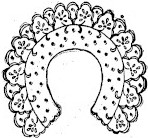
collar pattern
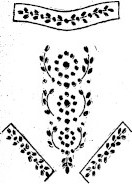
and front panel
patterns for shirtwaist
Women’s clothing, the seen and not-to-be- seen-in-polite-society, could have as little or as much stitching as the stitcher was willing to put time and effort in on. Removable collars and cuffs were often decorated with embroidery. They could be removed and gently washed and worn with different dresses. The collar design to the right (Fig. 20) can be found in the Farmer’s Wife for July 1, 1910.
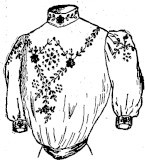
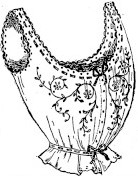
Shirtwaists were also personalized with embroidery. A shirtwaist pattern design to the left (Fig. 21) can be found in the Farmer’s Wife for July 1, 1909. When embroidered on a shirtwaist in the colors that were chosen personally by the stitcher, she would have a one-of-a-kind blouse displaying her stitching expertise. Corset covers could be embroidered with delicate flowers, vines, and leaves, like the corset cover design to the right (Fig. 22). Both the finished shirtwaist and corset cover can be found in the Farmer’s Wife for September 1, 1909.
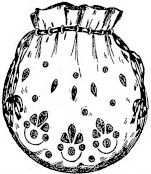
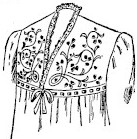
Nightgowns, like corset covers, were worked in delicate motifs. The nightgown design to the right (Fig. 24) can be found in the Farmer’s Wife for June 1, 1909. Accessories such as belts, purses or bags, hats, scarves, and even skirt panels could have embroidery applied to them. If you could wear it, you could embroider it. The handbag and belt designs to the left (Fig. 23) can be found in the Farmer’s Wife for June 1, 1910.

belt patterns

The hat (cover) design to the right (Fig. 26) can be found in the Farmer’s Wife for July 1, 1907. The hat design confused me at first; how could that be a hat—it would be like setting a centerpiece on your head! I discovered that a plain hat with a small brim was covered with the work (centered on the crown of the hat) and a small band was placed around the part of the hat where the crown and brim meet to hold the piece in place! That way, you could have a plain hat as the base for many different hats—you’d just swap off the embroidered (or crocheted) piece to change your look.
I hope you have enjoyed looking at these sketches of embroidered works from the past and that they have inspired you to go have a look in the IDNC’s database for ‘fancy work’ or for whatever strikes your fancy!
Help with Text Correction
The newspapers in the Illinois Digital Newspaper Collections are searchable because of computer-generated text that underlies the page images. This computer-generated text is far from perfect! You can help improve the accuracy of keyword searches by correcting errors. Thanks to the hard work of volunteer text correctors, more than a million lines of text have been corrected so far.
Register to become a text corrector.
Learn more about how to help correct newspaper text.